#vpoc writes
Note
Please tell us more about characters assigned rocks 👀
Oh no my trap card! long post time!
Okay, the rocks that I assign to characters depend on a lot of different factors (mostly vibes), am I planning aesthetic matches? eg. rubies and garnets for technoblade? Narrative matches? eg. gypsum for dream? Character matches? vibe or function? eg. feldspar for techno, muscovite for phil? The result is a pile of different rocks assigned to each of my special little guys, some with more uhh tenuous connections than others.
Let's go over the rocks I assigned to the syndicate (+dream) and why:
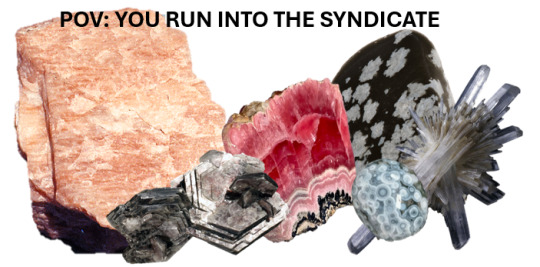
First up, Technoblade and K-Feldspar:
This is one based mostly off of vibes. It's one of my favorite feldspars and Technoblade is my favorite guy. And orthoclase feldspar, or K-feldspar, is PINK.

But I am nothing if not able to make explanations for things that were initially just based on vibes. Let's look a little beyond, shall we? Feldspars are known for being very structured in the sense that they have two defined cleavage planes at 90 degrees to each other, making rectangular blocks with irregular ends. Techno, to me, is the pillar of support and structure to his friends, so a cleavage pattern that reflects that is fitting. (in contrast, I think Ranboo's character could be represented by obsidian, which is glass-like). Beyond that, feldspar is the most common mineral in the earth's crust, making up about 60% of the crust. In terms of Technoblade, this could represent his impact on the mcyt community, his character's role in driving many major plotlines, or if you like the old immortals hc, a lasting impact on the world throughout history. (If you like the old immortals theory, please consider pairing feldspar techno with olivine philza! Olivine is a green mineral, the most abundant in the upper mantle!)
A couple other notes: K-feldspar is pink because it has iron mixed into it, but it's named for the high concentration of potassium. Potassium is also known for: exploding! Also. It's PINK. But, generally I do tend to associate feldspars with Philza instead of Technoblade, because feldspars are what makes moonstone and labradorite, and I tend to associate moon and star mythos and symbolism with Phil.
Philza and muscovite:
I know I just wrote muscovite, but I was thinking of fuchsite, which is a chromium-rich muscovite!
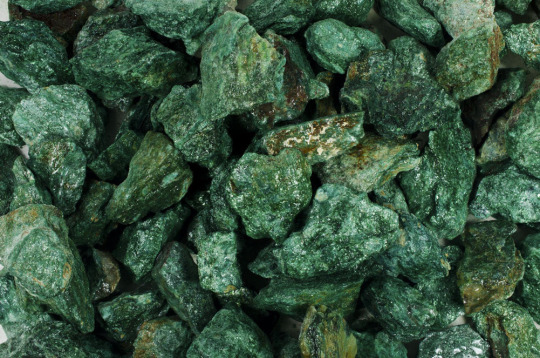
I can't really put a finger on why I feel that muscovite fits Phil so well, but I think the micas suit him. Maybe it's something about how they used to use Mica to make windows (Muscovy glass, from Moscow, gives muscovite it's name!), and I feel that Philza's builds and character act as windows into rich worldbuilding. Maybe it's something about the fact that micas are made of many many layers and Philza adds a depth to each of his characters (and even literal layers with the colorzas). Muscovite is generally clear and reflective, while biotite micas can be dark enough to be black even in thin sheets. both suit Phil in my opinion, but the inclusion of alluminum in muscovite sometimes gives it a metallic sheen. It can be thin and transparent sheets, but it's still durable and versatile as a material. Maybe that reminded me of how people always see Technoblade as the warrior, but Philza has been known as a survivor for just as long if not longer.
Connor and Ocean Jasper:
I'm going to be honest. I know nothing about this guy.
Ocean jasper is blue. He's blue. What more is there to say?

Ocean jasper, or orbicular jasper, is a pretty rare stone! The main reason I assigned this to C!connor, other than the color, is that from the little I knew of his character, he was still somehow everywhere. That sums up my understanding of jasper pretty well too! It's a silicate mineral, defined more by its crystal structure than its composition, but some people still just call it chalcedony or quartz, and jasper is everywhere with lots of varieties! It reminded me of seeing all of C!connor's appearances with his normal skin and all the time traveler theories. The same Connor under different names, the same quartz under different names.
Niki Nihachu and Rhodochrosite:
This is the one I feel fits the best, actually! Yes I did initially think of it because it's pink, but Rhodochrosite is an extremely cool mineral and I think the fact that people think of it as "just pink" reflects perception of Niki's character compared to her true depth.
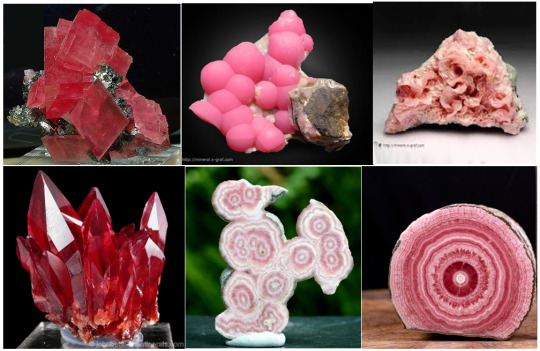
Just look at the versatility of it! From crystals to roses to speleothems. Rhodochrosite has been used for manganese, which is used in steel and aluminum allow production, or to concentrate silver. In both cases the process is destructive and creates a lot of byproducts, which reminded me of the hurt caused to C!Niki through the revolution, and the way she was spoken over and ignored after. Another aspect of rhodochrosite is that it generally forms in hydrothermal veins. High pressure formation conditions to create this beautiful mineral reflect, to me, Niki's arc of finding herself again.
Ranboo and Snowflake Obsidian:
I think any obsidian fit's C!Ranboo well, but you know I had to choose snowflake obsidian because it's black and white.
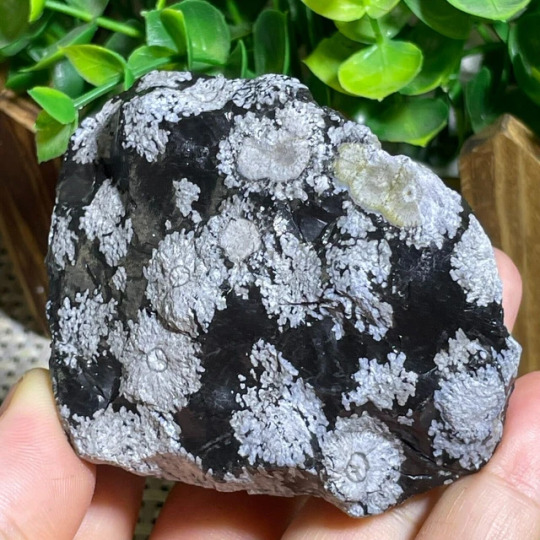
Ranboo's fragmented memory made me think that a fracturing material would be a good fit, and obsidian has the properties of glass. It is also not lost on me that obsidian forms when magma or lava hit water. However, snowflake obsidian forms through the process of devitrification (vitri-, like vitreous, meaning glass-like), where glasslike substances become crystalline. The white material is cristobalite, a silicate material that forms at high temperatures. What this means is that snowflake obsidian is not as glass-like as other types of obsidian, just as Ranboo's memory loss is not exactly what it first appears to be either.
Dream and Gypsum:
Gypsum, in some forms called selenite, is a pretty well-known mineral. However, many of the forms are known under different names so people do not realize that they are all the same mineral.
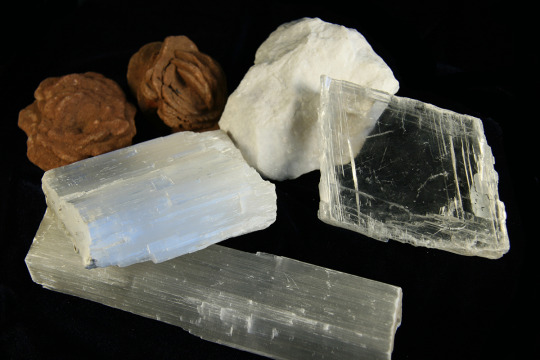
Gypsum can form roses, clear selenite, reflective satin spar, the sands of white dunes, rock, crystals, and more. It's used in construction, to make chalk, to make buildings, to analyze mineral thin sections, to measure hardness on the Mohs scale, and to charge crystals by those that believe in spiritual properties of minerals. I see these many different forms as parallels to Dream's many faces on the server, real and perceived. Many different names given to different forms of the same person. I think the many used of gypsum also reflect the perception of Dream by the rest of the server. Gypsum is attributed power by some (is Dream the most powerful villian on the server?) and use by geologists and builders (Is Dream a way to get the revival book? Is he an ally?), but one of the main qualities is that it has a very low hardness, and is very easily broken. Is the role and name assigned to Dream, by others and by himself, more than he can fulfill without breaking?
#vpoc yells#vpoc writes#now i need a new tag that's 'vpoc talks about rocks for way too long'#dsmp#rockposting#the syndicate#uhhh I don't know what tags to use for this tbh#long post#If someone wants I can list some vibe-based rocks for my guys too
46 notes
·
View notes
Note
Au question! What's your favorite concept for adult Scout and Juniper in the terrible two au? -vpoc
english major scout!!
i like to think they get really into literature and writing. c!techno is always reading them old greek myths and c!dream is always encouraging them to write (never admits to his wattpad fics, though). so they end up as a writer! also they love to cook, they're very good at it.
as for juniper, she's really great at archery and also she becomes something of a vet. both her caretakers love animals. she's heard some stories, later on, about the ill-fates of some of dream's animals and has seen how techno cares for his. so she grows up to take care of them!
both of them have good relationships with their 'extended' family and when they go off on their own, they send letters back to everyone. techno and dream write back religiously.
18 notes
·
View notes
Note
🍪 If you were a cookie, what kind would you be?
And 🙃 what's a weird fact you know?
For the ask game! Hope you're having a good day!!
-vpoc <3
🍪 — hmmmm … maybe chocolate chip? I really like chocolate chip cookies, they’re my preferred cookie of choice
🙃 — oh god this is one of those questions where I won’t be able to think of an answer right now but a really really good one will pop into my brain a few hours/days later and I’ll be like DAMN why didn’t I write THAT. Maybe I’ll reblog this post with my answer when I think of something good haha
And thank you I hope you’re having a good day too :D
(Ask game)
3 notes
·
View notes
Text
To DO
Add volume profile details; and see how price reacts to VPOC.
Use VPOC for S/R...can it be done in stocks?
Write commentary on inter-market relationships -obvious currency, gold, oil;
bonds, stocks; yen - markets; etc
sentiment indicators - P/C ratio, AAII , Investors Intelligence - Youtube notes
_ FieldOfVIsion - notes - good insights thrown in
0 notes
Text
Okay, so Technoblade, right? I really love all the blood god/god of war/god of justice/god of covenant concepts, but Trade is always the one that stuck out to me. A while ago I said this:

So I'm gonna elaborate now. Long long post warning!
Trade with villagers: I think what started this idea for me was the amount of time he spends in villages and also my mental association of Techno and piglins. When he was setting up his trade system in dsmp he didn't set up farmer villagers even though he almost exclusively ate golden carrots. And he didn't set that up because there was a village nearby that already had farmers. It was one of the few cases I saw of a minecrafter treating villages like established communities, where you go because of their skill in a trade and respect the villagers for their established community, and then find sources for other materials on your own. A bit of a tangent, but Techno has more respect for mobs than most players, to the point where it's noticeable in his playstyle, and occasionally at disadvantage to him. Anyways, Technoblade trades in and out of his established trading hall, foregoing more efficient trades for the value of an established community. But still, the interactions are transactional. He goes to the village, trades, leaves. Heals zombie villagers, gets better deals from it, trades, leaves.
Why not a god of death or war?: you see, I don't think that saying Techno is a god of trade is saying that he isn't a god of blood or death or war. I think it just broadens what topics he covers and explains some of his behavior in a different context. If you think about it, what is death other than an exchange from life to death caused by an action? In many cases in the dsmp, Techno's violence is the result of a threat. His life and survival came at the cost of those that were threatening it. This is complicated by his principles on the dsmp but much more obvious on smp!earth, where the policy of the Antarctic Empire was very much "an eye for an eye". But even in the umpteenth war with Tommy in smp!earth he still prioritized negotiation and fair terms. The analogy falls apart a bit when considering the hypixel games, until you consider that life in that server literally converts to coins that can be used in trades.
Hospitality: this is another one I really want to discuss. Technoblade explicitly states on the dsmp (i think around when tommy shows up in his house) that he follows the principle of Xenia. Xenia is a Greek principle of hospitality or "guest friendship" focused on providing protection and generosity to guests by moral obligation as the host. Importantly, xenia is rooted in the importance of reciprocity, and Techno greatly values reciprocity. This is part of what made Tommy siding with Tubbo again such a betrayal to Technoblade. Techno at that point was providing hospitality and protection under a moral obligation, with an expectation of equal understanding that just wasn't there. This concept is also reflected when he says "Those that have treated me with kindness, I will repay that kindness tenfold. And those that treat me with injustice? That use me?! That hunt me down, that hurt my friends? I will repay that injustice a thousand time over" There is the expectation of repaid kindness and exchanged favors that treats interactions like trades. But in this case, the trades between justice and injustice are not equal to the trades of kindness.
This is because Technoblade also trades in trust (hello god of the covenant enjoyers. Love y'all). And when injustice is dealt, not only are the expectations of hospitality and returned favors broken, but so is the trust placed in that person. And trust is a very valuable thing to trade away.
I don't think Technoblade views everything as a transaction. However, I do think that the treatment of his character in the DSMP heavily favors this perspective and that aspects of a transactional view were adopted by his character as a defense mechanism to survive in that world. This brings me to my next topic
Technoblade as "The Blade": This is seen in several other series' where Techno is treated as a weapon or a sort of bargaining piece more than a person. This is most evident in the DSMP, since most other situations involve Technoblade as part of a team. The other examples that come to mind are Techno being added to the ultimate uhc charity event in replacement of two people, Techno being targeted in mcm and other events with no intervention to stop cross teaming by his opponents, and Wilbur offering to let the rest of the Antarctic Empire off free if Techno took all of the blame for taking over the world.
Now to the DSMP. Techno trades his own life as the blade, as a sell sword. He joins Pogtopia even though he wouldn't have been invited to Pogtopia and his reputation precedes him. He trades skill and time for what he thinks is support for goals similar to his own. But even when he is gathering supplies ans farming he gains the nickname "the blade." He is seen as a weapon, summoned for battle, and otherwise treated more like a sell sword than as someone who joined the resistance for his own reasons. Later, he is called an animal and a pig by the butcher army and leaves his retirement in order to survive. Once again he trades peace for war largely due to the perception of others that he is a tool of violence. His reputation on the server preceded his personhood to many. This is especially important after the revengers' stream, when it is revealed that Technoblade only had one life the entire time he was on the server. And at this point Technoblade also reveals that he now thinks that his life is worth it to stand by his values. Technoblade, always treated as a weapon and a means to an end, views his own life as a reasonable cost for his values.
And Technoblade values life and trust almost as much as he values freedom from oppression, but he always prioritizes his values.
In the DSMP Technoblade gives Ranboo a place to stay after doomsday. He trades his safety in his isolation to help another person. He trades favors with Dream but does not trade his obligation to Tommy as a guest for that favor. Philza talks about life over objects, Technoblade values life and freedom over disagreement, since one of his main values is the ability to choose and live freely.
Technoblade trades himself. Trades his trust. Trades his time. Over and over and over again, just to get closer to the world he's trying to reach. He trades isolation for trust gradually. He trades good treaties for his empire for mutually beneficial ones. He trades time and effort for growth. He trades hospitality and protection at the cost of his own safety for the lives of others. He trades, and he trades, and he trades, and the others around him are constantly affected by it, as is he.
#vpoc yells#technoblade#c!technoblade#found this in my drafts and decided it was time to finish it.#mcyt#character analysis#long post#not gonna lie the way he trades with villagers and the potato war are the main inspiration for this. but i stand by the rest too.#techno as trade my beloved#vpoc writes
669 notes
·
View notes
Text
Everyone need to understand that Techno's character is just a little guy, but also a cranky old man. He's an emporer, and an anarchist, and just some guy that's trying to retire. He's a warrior and he always seeks peace. He's a farmer, and a trader, and a hunter, and an omen. He's the blade, and the blood god, and the best potato farmer you'll ever meet. He'll kill if he has to, and he'll hoard supplies and prepare for the worst, but he'll give his whole stash of golden apples to a fox so that it stops trying to eat blocks. He's quiet, and he's alone, and he's scared of the danger of attachment, but he'll scream at the top of his lungs if a zombie even looks at phil. He's quick to trust, and hurts so deeply, but he'll ally with an enemy for the greater good. He's unforgiving, and dramatic, and he'll help someone in a heartbeat, no matter the cost.
#okay i started this trying to be funny but then just rambled on instead#he is my blorbo and my skrunkly and you guys better be nice to him#mcyt#technoblade#vpoc yells#i wrote so much to say nothing at all#vpoc writes
483 notes
·
View notes
Text
Let's Talk Pyrite Disease
Okay. Pyrite is amazing. Pyrite, or fool’s gold, has a simple formula (FeS2), forms beautiful cubes, and has all sorts of cool features. I'll talk later about how iron minerals can move and change and how they're related to theories about cells, but first, let's talk about Pyrite disease.

Image ID: Several pyritized ammonite shells in various stages of decay. They all have a light-grey color and a velvety appearance. There are a few in the center that are severely decayed and appear to be just a pile of dark grey and yellow dust, with a similar appearance to mold. One ammonite in the top-center is a more gold-brown color and has cube-shaped pyrite crystals on it. End ID.
[Image by https://twitter.com/MSidKelly/status/667548523475288064]
TLDR: Pyrite disease is a form of rust that impacts pyrite. It produces iron oxides, sulfuric acid, and sulfur dioxide, damaging mineral specimens, fossils, and storage materials. It causes expansion and acid damage that cracks and erodes specimens.
oh and @simple-potato-farmer, @team-clockers, @edthefatmagicturtle, y’all expressed interest in this so here you go! warning: it’s 10 pages long
How Can Fossil Come in Contact with Pyrite?
Pyrite is the most abundant sulfide mineral. Pyrite is found in quartz veins, coal mines, sedimentary rock, metamorphic rock, and in fossils as a replacement mineral. Pyrite forms in anoxic environments, which makes it a good environmental indicator. It also means that pyrite is found in association with many deep ocean fossils.
Fossils can be replaced by pyrite. This happens in a process called pyritization, a form of replacement diagenesis where the original material of the organism (in some cases, even soft parts) is replaced by pyrite. For instance, due to the anoxic and high-sulfide concentration in the deep ocean, calcite shells may be replaced by iron pyrite. This is aided by the presence of sulfur-reducing bacteria that facilitate the creation of iron sulfides, and therefore facilitate the precipitation of pyrite during decay(1) as sulfides are produced by the decaying organism(2). In a unique case, high microbial activity led to documentation of pyrite formation on the shells of living mollusks(3). This process leads to beautiful pyritized fossils that look like metal casts but actually are the fossil completely replaced by pyrite.

Image ID: An ammonite cut in half to show pyritization. The entire ammonite appears metallic gold, and the internal cavities contain fine drusy pyrite crystals. End ID.
[Image by: Replacement/Recrystallization (petrifiedwoodmuseum.org)]
Not all fossils end up beautifully pyritized, and not all pyritized fossils stay that way. Pyrite disease, also called pyrite oxidation, pyrite rot, or pyrite decay, is a form of rust. Millions of years of history, only to be destroyed by poor archiving, humidity, and pyrite decay.
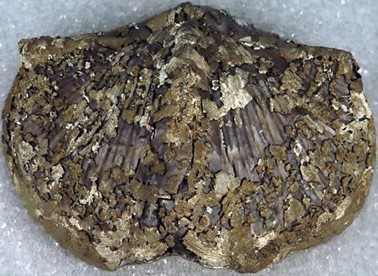
Image ID: A brachiopod specimen with pyrite replacement and a patchy outer coating of pyrite. Unlike the ammonite, the pyrite has grown over the shell of this brachiopod in addition to replacing the original structure. End ID.
[Image by: jsjgeology.net/Replacement.htm]
What does Pyrite Disease Do?
Since pyrite is formed in anoxic conditions, most pyritized specimens remain stable for a long time. The reason we observe so much pyrite decay in museum settings and other fossil collections is because the specimens have been removed from the rock and sediment that were limiting their exposure to oxygen. Pyrite decay can occur with or without water, but when pyrite oxidizes in humid air, it reacts with both oxygen and water. This creates not only iron oxide ‘rust’, but also iron sulfate, sulfuric acid, and sulfur dioxide gas4 (corrosive and toxic materials)(1). This chemical reaction eventually destroys the specimen through a combination of factors. The sulfuric acid is corrosive and damages the specimen. Oxidized pyrite is unstable and may crumble over time. There is also another damaging factor: the risks of pyrite replacement and iron sulfate production.
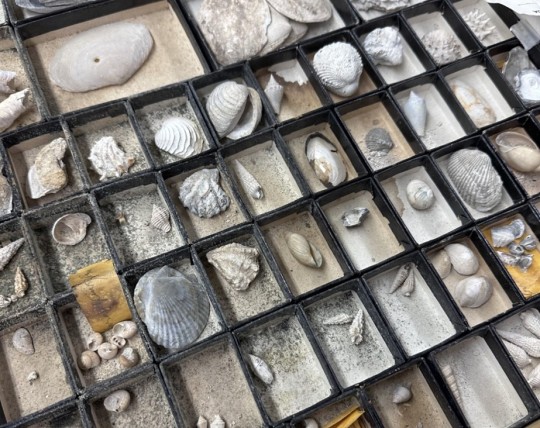
Image ID: A tray of mollusk fossils, each with separate boxes, with evidence of pyrite decay. There is dark grey dust in the bottom of most boxes, and a line of what appears to be water damage across the boxes. The apparent water damage is the result of the sulfuric acid produced. It has also discolored fossils and their labels. End ID. [Image by me]
Pyrite disease is a progressive process that affects fossils over time. Many pyritized specimens may last for years in perfect condition, while many others progressively decay from undetected pyrite disease. The reason that pyrite replacement is notorious for decay has to do with the crystal structure of pyrite. The famous cuboid structure of pyrite crystals is the most stable form of pyrite(4) since the compact form does not easily absorb moisture. Pyrite may occur in a compact, crystalline, stable form or a porous microcrystalline form that is unstable. Certain formations produce more stable pyrite with fewer impurities, but certain fossils are also more susceptible to unstable forms of pyrite. Marcasite is a less common dimorph of pyrite that is more unstable(5). Ammonites, especially those from the Charmoth clays, are notorious for pyrite decay while South American specimens and Yorkshire coast fossils are much more stable(2). The iron sulfate that is produced by the oxidation process is considered an efflorescent mineral(5), a term that means “flowering.” This is because this material has a higher molar volume (the ratio of the volume occupied by a certain amount of a substance) than iron pyrite and wedges the specimen apart as it expands past the constraints of the original crystal structure(5).
Unfortunately, the creation of efflorescent minerals, including other hydrous sulfate minerals, creates a feedback loop. These materials produce acids and provide water that causes the pyrite to further decay, producing more Fe3+ and more efflorescent materials, which feed the cycle of oxidation(5).

Image ID: Two images of the same pyrite disk, taken two years apart. In the left image, the disk has a few cracks and white discoloration in the center, with a yellow outline around the discoloration from sulfur. In the right image, the disk is shown two years later, cracked into four large pieces. The discoloration now extends almost to the edges of the disk, with a much larger yellow margin. End ID.
[Image by Ed Clopton, General: Need 'Pyrite Disease' Photos (mindat.org)]
(For an interesting, related topic – pyrite decay is a risk in coal mining for a multitude of reasons, including the increase of pulmonary and respiratory disease after pyrite inhalation, the risk of silicosis, and the risk of spontaneous combustion caused by the exothermic reaction involved in the decay of high-sulfide deposits.)
What Does Pyrite Disease Look Like?
Pyrite disease may appear grey, greenish, black, red-orange, white, or sulfur yellow. A redder color indicates rust from other iron minerals other than pyrite. Since pyrite contains sulfur and pyrite oxidation produces sulfuric acid, it may have the rotten-egg smell often associated with sulfur. A metallic-iron smell may also be present. Inhaling the result of pyrite decay can be hazardous (in my experience, it caused migraines even when I double-masked before entering the room due to the severity of the condition of our collections. In most cases it is much less of a concern). If pyrite disease is found, wear gloves and masks and try to disturb the dust as little as possible. Remember that pyrite disease is worse in humid conditions, and these same conditions may encourage the growth of mold. The early stages of pyrite disease may appear as spots of discoloration on a fossil, a slightly duller appearance, additional crystallization, or cracking. Often, the first noticeable sign that is clearly identifiable is dust in the bottom of the box the specimen is in. In these early stages, the severity of the pyrite decay may not be detected until the specimen is moved or handled, and subsequently begins to crumble or leaves dust and a metallic smell on your hands. Later stages appear like mold and may have a fuzzy, cloud-like appearance. If you handle a specimen with pyrite disease, take care to wash your hands and dry them well before handling any other specimens, and check the container or the contaminated specimens and those that surround it so that they can be replaced if needed. In the worst stages of pyrite decay, what is left is not a fossil that may crumble if handled, but a pile of dust. Pyrite disease can affect vertebrate fossils, invertebrate fossils, botanical specimens, mineral specimens with pyrite, and the containers and shelving used.
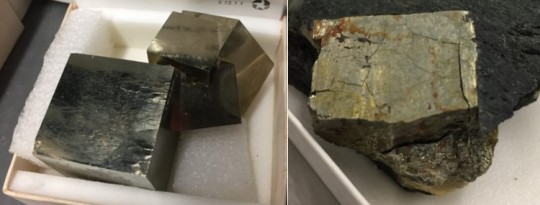
Image ID: Two images of cubic pyrite crystals. Left: Four cubic pyrite crystals growing into each other, they are a solid metallic gold color with few visible imperfections. Right: a cubic pyrite crystal in a dark matric. This piece is affected by pyrite decay, and the cubic shape is no longer perfect due to cracks in the specimen. It has orange and yellow sections that appear like water stains due to the sulfuric acid produced by pyrite oxidation. End ID.
[Image by Pyrite Disease - Canadian Museum of Nature]
Why Is It A “Disease?”
If the damage to the fossils themselves was not bad enough, consider another factor: it’s often called pyrite disease, instead of pyrite oxidation, for a reason. That reason is that pyrite disease spreads and progresses over time. Historically it was thought that this was the result of a bacterial component, and it was even recommended to treat fossils with antibacterial ointments(5). While bioleaching of pyrite is studied, bacterial theories are no longer supported. The spread of pyrite disease is due to the spreading of acid and the flaking of iron sulfates that may trigger decay on other specimens that already contain pyrite. Although this process is not contagious due to bacteria, it is still an irreversible process that causes fossils to crumble to dust and is, to an extent, a contagious process. The sulfuric acid and sulfur dioxide created in pyrite oxidation can damage the containers and fossils near the contaminated specimen.
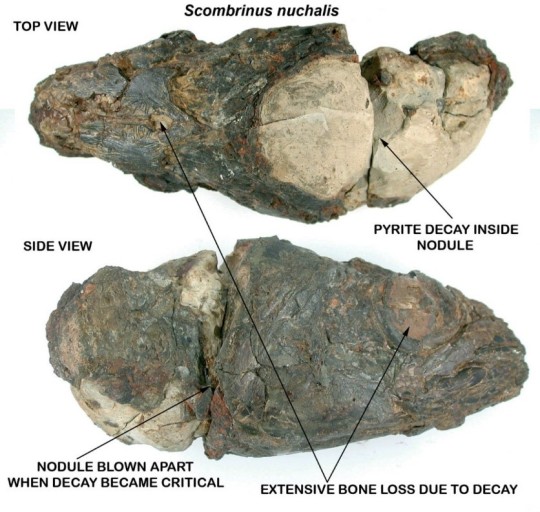
Image ID: An annotated example of a fish skull preserved in a nodule, which decayed and broke due to pyrite disease. There is a top view (top) and a side view (bottom, fish facing right). There are labels pointing to the top of the skull and to the eye socket showing cavities and red-orange rust labeled “extensive bone loss due to decay.” A white section of the nodule that is split and crumbled is labeled “pyrite decay inside nodule.” The side shows extensive decay to both the fossil and nodule, labeled “nodule blown apart when decay became critical.” End ID.
[Image by Trouble with pyrite – Deposits Mag]
One of the reasons that it is considered a disease is the progressive nature of pyrite decay, which visibly worsens over time. Another reason is the way that sulfuric acid seems to spread and contaminate even the container that the fossil is held in, leaving damage marks on the fossil and its labels. Another factor is the fact that the products of pyrite oxidation expand, appearing like mold or growths that further damage the fossil. The expansion of these oxidation products is one of the most damaging aspects of pyrite disease, as the instability in the crystal structure of the specimen causes cracking and flaking. This is because pyrite oxidation causes the conversion of iron pyrite (FeS2), an iron sulfide mineral that has a cubic crystal structure, to iron sulfate (FeSO4), which has an orthorhombic crystal structure. Not only does this cause the specimens to crack and crumble, but the cracking of the specimen causes flakes of pyrite to break off and spread. These flakes may land on other specimens, spreading the contamination of pyrite decay to other fossils that were previously stable. In many cases, museums must face difficult decisions to remove scientifically valuable specimens, or even portions of specimens, to prevent further spread of pyrite disease.

Image ID: Left: The crystal structure of iron pyrite. Right: The crystal structure of iron sulfate. End ID.
[Images by: mp-226: FeS2 (Cubic, Pa-3, 205) (materialsproject.org)]
How Can Pyrite Disease Be Managed?
Now, I’ve said that pyrite disease is unreversible. But can it be stopped from progressing once it contaminates a specimen? The simple answer is no. The more complicated answer follows:
Several factors that contribute to pyrite disease: temperature, humidity, oxygen levels, pH, exposure, crystal structure, and bacteria(3). Some factors, such as bacteria and pH, require specific conditions that are uncommon (Thiobacillus bacteria are present over 95% humidity(3) and pH is often affected by the decay process and the methods used to manage it). Other factors are closely linked (e.g., temperature and humidity).
Pyrite disease is most closely linked to humidity and high oxygen conditions. The best way to stop pyrite disease is prevention. Most museums use some form of climate control to preserve their specimens, but the issue here is that vertebrate fossils (bones) have a moderate recommended relative humidity level (~45-55%) in order to avoid cracking or warping6, while the recommended humidity level to prevent pyrite disease is 30%(7) (although below 50% is also stated by some sources(2,8)). In contrast, humidity above 60% is known to accelerate the decay, even to the point that decay begins within a few days of exposure(3, 2). This low humidity level is not always possible, especially for public display, although it is used in some invertebrate collections. Using humidity and oxygen scavengers (e.g., silica gel packets) when collecting can reduce the exposure of specimens to these factors. Using humidity and oxygen barriers when storing specimens can prevent pyrite disease(3). Contained storage of an already contaminated specimen may trap moisture with the specimen. Although, I would say it is better to have an isolated specimen that decayed than have an open specimen contaminate others.

Image ID: The unpolished appearance of a pyritized ammonite. The ammonite is held in front of a rocky area. It is a dull grey color with a matte appearance. It has lumps of rounded pyrite surrounding it. End ID.
[Image by Martin Curtis, Pyrite Decay in Fossil Collections – ZOIC PalaeoTech Limited (zoicpaleotech.com)]
Since the damage from pyrite disease is exacerbated by sulfuric acid, one of the other prevention methods used relies on acid neutralization(5), although this is less common. Currently, the use of humidity and oxygen buffers is the most common method, but some groups rely on extensive testing of specimens to determine which have unstable forms of pyrite incorporated into the fossil or matrix before acting. Another preventative method is removing salt (which may speed up the decomposition) and removing any matrix that may contain pyrite or trap moisture (e.g., clays)(5). Washing specimens to remove salts or matrix remains could damage specimens that are already unstable or could cause damaging moisture exposure (although this could be avoided by washing with alcohol).
Many studies have attempted to find effective ways to stop, reverse, or prevent pyrite decay. From acid treatments to preemptively coating specimens in resin, these tested methods were often damaging to the specimens, especially over the long term. However, were they damaging enough to be worse than pyrite disease? Not necessarily, but a combination of the damage done, the cost, the time investment, and the ineffectiveness of these treatments means that prevention is still the only reliable method for pyrite disease.
Coating specimens in resins and varnishes may provide a buffering effect, but the resin only slows oxidation, it does not stop it. This becomes an issue when the vanishes cannot be removed, and the specimen cannot be accessed for other treatment methods(2). Varnishes may delay the effects, but they have effects of their own, are usually not moisture-proof, and may yellow and crack over time. Coating with resin or embedding the fossil in resin creates the risk of an explosion as the oxidative reaction builds heat and pressure. Some museums coat their fossils in plastic glues (such as Paraloid B-67 or B-72), these glues are reversible, and B-67 is hydrophobic, unlike most resins.
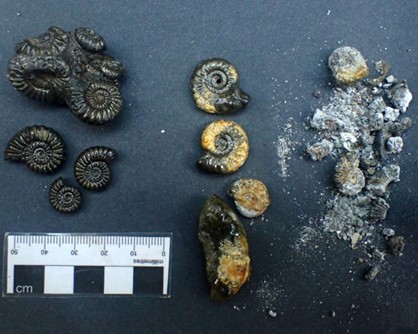
Image ID: Examples of varnished ammonite specimens, showing progressive stages of pyrite disease as the varnish aged and cracked. Left: Complete pyritized specimens with no signs of decay and a glossy finish from the varnish. Center: Pryitized specimens with patches of yellow-orange decay in sections where the varnish cracked. Right: specimens reduced to dark grey and white dust. End ID.
[Image by Chris Andrew, Pyrite Decay in Fossil Collections – ZOIC PalaeoTech Limited (zoicpaleotech.com)]
There are two “cures” to pyrite decay. However, these do not cure pyrite decay in the sense that they reverse it. Instead, these are methods to neutralize the products of pyrite disease to prevent further harm to the specimens. These two methods involve the use of ammonium gas or ethanolamine thioglycolate to remove pyrite byproducts (ammonia converts the iron sulfate to iron oxide(8)) and neutralize any generated sulfuric acid(2). Both methods are intensive, potentially hazardous, and relatively expensive. As a ‘cure,’ they are effective at temporarily halting the progression of pyrite disease, but not preventing it or reversing it. These treatments have been proven to be ineffective at preventing pyrite decay without the use of controlled microclimate (oxygen and humidity exposure)(3).
References:
1 Replacement/Recrystallization (petrifiedwoodmuseum.org)
2 Pyrite Decay in Fossil Collections – ZOIC PalaeoTech Limited (zoicpaleotech.com)
3Minerals | Free Full-Text | Pyrite Decay of Large Fossils: The Case Study of the Hall of Palms in Padova, Italy (mdpi.com)
4Pyrite Disease - Canadian Museum of Nature
5Pyrite disease (palaeo-electronica.org)
6Shells Eggs Bone and Related Materials 160229 (welshmuseumsfederation.org)
7PowerPoint Presentation (vertpaleo.org)
8Trouble with pyrite – Deposits Mag
#vpoc writes#rockposting#vpoc yells#pyrite disease#pyrite oxidation#vpoc has cool rocks#other cool rocks#long post#paleontology#geology
61 notes
·
View notes
Text
Technoblade is love.
Technoblade is blood: in the sense of family, and life, and exchange, and growth, and bonds.
Technoblade is harvest: in the sense of time, and hope, and change, and giving.
Technoblade is war: in the sense of trust, and protection, and justice, reciprocity, and the peace that follows.
Technoblade is death: in the sense of new growth, and cycles of life, and hope, and the appreciation of impermanence.
Technoblade is love. He is hope, and change, and peace, and growth, and trust, and love.
#thinking about him....#shoutout to Loyal's stuff!! he is harvest!! and culture! and growth!!#technoblade#vpoc writes#sure technoblade is everything that his enemies claimed he was. blood and death and the blade. but never in the way that they meant it
76 notes
·
View notes
Text
Let’s talk Technoblade and flower symbolism!
(please note that these are the reasons that I use these specific flowers in my art for Technoblade, usually in reference to DSMP techno, so not all of the reasons are serious or symbolism-related :D)
(Part two here)
Dandelions
Not only do the common meanings of dandelions perfectly match Techno (faithfulness, hope, growth, and healing) but societal impressions of dandelions, to me, are a perfect reflection of Techno’s character and of his arc in the DSMP. I won't go much into faithfulness and healing, but I hope that those are evident from his friendship with Philza and the healing of each member of the Syndicate.
Loyal talks about Techno collecting dandelions (Here!), discussing both the symbolism of Techno growing in an adverse environment and collecting hard-to-kill flowers and the fact that Techno uses the dandelions for stew and for his bees.
I think Techno’s use of suspicious stew is often overlooked. A suspicious stew made with dandelions increases saturation. He didn’t choose to create regeneration effects using an oxeye daisy. Technoblade, who focuses on xenia, guest friendship, the laws of hospitality, and the policy of providing food and shelter to guests; Technoblade, who chose his retirement to avoid the conflict and violence of his past and was still hunted anyways, chooses saturation. The choice to rely on dandelions was intentional. It was a declaration, perhaps just to himself, that he was retired, that he would not need regeneration, that all he would need is to be able to provide the hospitality of a filling meal and to protect himself and his friends from hunger.
Now, let's talk about society and dandelions. Dandelions are considered by many to be a weed, an unkillable plant that spreads it's roots even after they try again and again to get rid of it. Sound familiar, anyone? But, like many "weeds," the reason that dandelions are seen as undesirable has roots in colonilization, where plants that were food sources to native and impoverished peoples were derided by colonizers and the upper class. The societal perception of these flowers is rooted in their usefulness to those that the figures in power wanted to eliminate.
Other than that connection to Technoblade's anti-government perspective, why am I connecting this to our favorite anarchist pig? Consider Technoblade's role throughout the dsmp, specifically the pogtopia arc. Technoblade provides armor, food, tools and materials. Then there is a shift in power and his 'usefulness' is up, as those in power no longer align with his goals and instead try to eliminate him. This shift in being recognized for usefulness to being forceably removed is due to a shift from the group in power, despite being the same as before.
I don't want to limit this analogy to usefulness, although the tendency of Techno to provide food and hospitality does lend itself to that. No, the main reasons that I connect Technoblade to dandelions is their resilience, their potential for growth, and the hope they represent.
Technoblade retires. Technoblade is executed. Even before this, it is evident that Technoblade needs healing. He has the air of a war veteran, is referenced to as the blade, is used, betrayed, and fights for his life. He says that there is no safety except isolation. And yet, he retires and throughout it all there is his friendship with Philza, his cabin in the arctic, his suspicious stew; pieces of evidence that he never gave up hope that he could heal without violence. Pieces of that undying determination that both he and dandelions are known for. Dandelions can grow on rocks, on hard packed soil, in drought conditions, but they prefer rich soil like any other plant. Technoblade grows his hope in hard conditions, fights to keep that hope, and finds a place where it can grow. He finds a place where he can grow, and learns along the way that maybe faithfulness is not a weakness, and maybe you can live and grow with others.
#there will be a part 2! I'm still working on it!#here it is here's the technoblade and dandelions post!#vpoc yells#technoblade#c!technoblade#I'm sure i missed something but oh well#long post#vpoc writes
77 notes
·
View notes
Text
Another rock post be upon ye!! How about.... OPTICAL CALCITE
Also called Icelandic Spar or even Viking sunstone!

Despite all of the fancy names, optical calcite is essentially just exceptionally clear calcite. However, calcite is so cool and deserves all the love <3
Fun properties, double refraction, and the reason behind the names below the cut!

Calcite is called Icelandic spar, due to the area it was most famously mined. It may be called optical calcite if it is exceptionally clear. Calcite (CaCo3) has several notable qualities! Some that are commonly used for its identification are: 3 on the Mohs hardness scale, twinning, birefringence (if y'all ever want a brain melting post I will totally deep dive into birefringence for y'all, I'll talk about a lot of the basics of it here!), effervescence with hydrochloric acid, and distinct cleavage planes. The cleavage is probably the most well know! Look at those perfect 6-sided polyhedrons below! It has three perfect cleavage planes at 60-120 degree angles.
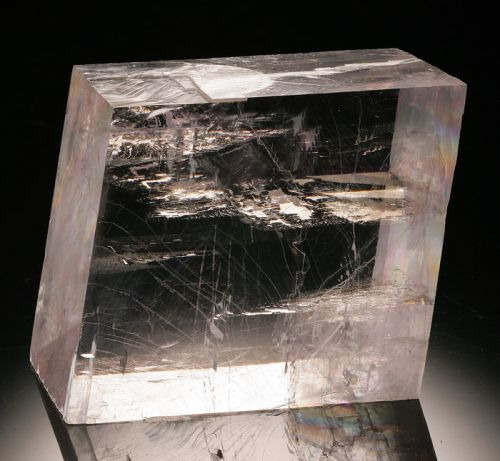
However! What I will be talking about most are the optical properties that give this mineral it's nicknames!
Calcite has a very cool property called double refraction! This is a principle of birefringence (which means that light passing through the crystal refracts at different angles for different polarizations. think polarized lenses in sunglasses that block light moving at a specific angle!). Unpolarized light passes through the calcite and is polarized by the crystal! Splitting it into two rays, one moving in the original direction and one splitting off, causing images to appear doubled!

Since the double-image is caused by the distortion of light as it passes through the crystal, the size of the crystal impacts the spacing of the images (as shown above in the chart and below in an example with three pieces of calcite)

The 'ordinary ray" (original path of light) makes an image that stays in place, but rotating the crystal causes the double of the image (the extraordinary ray) to move. The double image occurs if the direction of the polarization is at an angle to the ordinary ray, rotating the crystal 90 degrees can cause the polarizing direction and the ordinary ray to align, eliminating the double image (shown below).

Interestingly, trilobite eyes are made out of calcite! The many lenses of their eyes are all oriented at the C-axis of the calcite crystal, the only axis that aligns the incoming light and polarized direction, eliminating the double image!
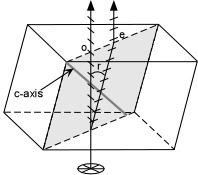
NOW TO THE MOST FUN: WHY IS IT CALLED A VIKING SUNSTONE?
When most people think of a sunstone, they think beautiful feldspars with shimmery orange flecks, or of the man-made, glitter-filled orange stone.
When historians came across discussions of sunstones in Norse texts, they at first thought it was a reference to some mythical stone, or perhaps a real stone tied to mythology in its origin. Then, more texts discussed the use of this "sun stone" in navigation. It wasn't until years later that it was proposed that the sunstone could be calcite, because there was no clear description of how to use a sunstone.
There are two proposed methods for using a sun stone in navigation, the simpler dot method and the more commonly accepted color method (not official names, just the easiest way for me to describe them).
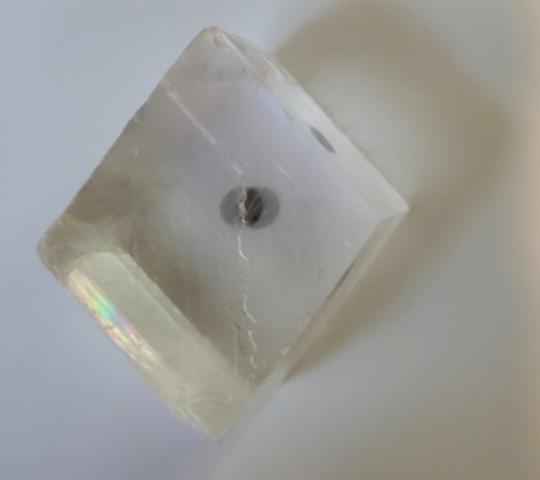
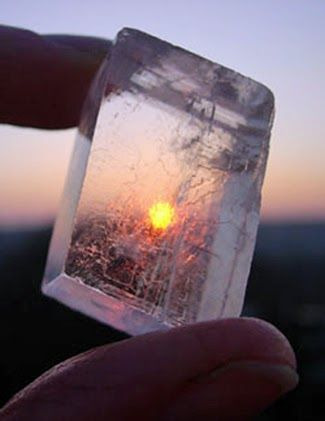
The 'Dot method' involves drawing a mark on one side of the calcite piece. Using the properties we discussed before, and holding the stone at the correct angle, you can calculate the direction of the light source by looking through the stone until the double image of the dot on the opposite side turns into one image. Because rotation affects this process, and because some texts refer to the color yellow, this is the less supported theory.
The 'color method' involves moving the stone until it appears yellow, which is caused by a phenomenon called Haidinger's brush. This makes it so that polarizing minerals may show a yellow pattern when facing away from the sun. This pattern appears more distinct against blue backgrounds (e.g., the sky) and is brightest 90 degrees away from the sun. When tested, it was found that you could calculate the East-West direction within a few degrees by finding the two points where the yellow color was brightest and calculating intersection, even when the sun was behind clouds or set beyond the horizon line.
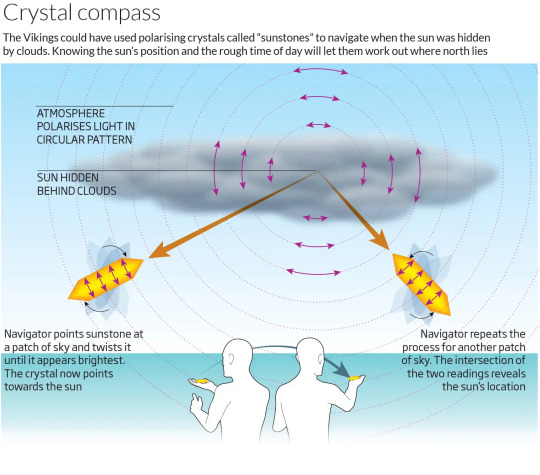
Thanks @earthgeco for requesting more rocks!!! You have activated my trap card. As in. You are now trapped with me as I tell you about rocks. (I have more posts under my rockposting tag as well!)
Image sources: 1, 3, 4, 7, 9, 10
Images from me: 2, 5, 6, 8
#vpoc yells#rockposting#optical calcite#icelandic spar#vpoc has cool rocks#long post#vpoc writes#me writing this: why did my teachers not use these diagrams. why didn't they explain it this way instead. what. huh.
14 notes
·
View notes
Text
Alright folks, time for another rock post!
Now, gather around while I break out my notes from the worst class of my life (the class of the trip-from-hell-we-do-not-mention) to tell you about my good friend DOLOMITE.
Here’s Mine:
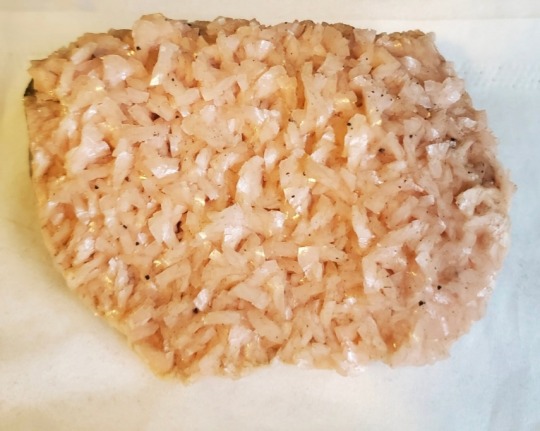
Now. I hear you clamoring, asking WHAT IS DOLOMITE AND WHY IS YOURS PINK? Great questions! Mine is pink because it is cooler than all that other dolomite.
(Actual explanations, cool pictures, and more detail under the cut!)
No, it’s because mine has manganese in it. Manganese has multiple oxidation states, and one is manganese (II) chloride, which is a pale pink color. Dolomite is usually white, but can be grey, pink, or even tan.


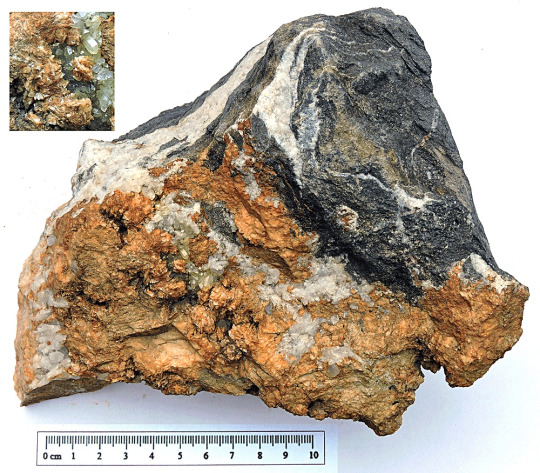
Dolomite is considered a double carbonate! This is because it has an alternative structure where the carbonate (CO3) is either paired with a magnesium or calcium ion. Interestingly, dolomite is also sometimes considered a type of limestone!
Dolomite, despite the groans of the poor geology students that had to memorize the 3 main formation methods and six methods of dolomitization (QUICK, POP QUIZ GEOLOGY STUDENTS! GO GO GO!), is pretty cool! It is a calcium and magnesium-based mineral (CaMg(CO3)2) that is much more common in ancient rock formations than modern ones. It can form directly from precipitation, which creates dolomite crystals, or from dolomitization and dolomitizing fluids. Dolomitization is a process of replacement diagenesis in limestone or other calcium carbonate rocks. This means that the limestone (CaCO3) is replaced by dolomite. This can happen because the Calcium ions and magnesium ions have the same charge, and magnesium rich fluids may cause a magnesium ion to replace a calcium ion (Mg + 2CaCO3 ➤ CaMg(CO3)2 + Ca), forming dolomite.
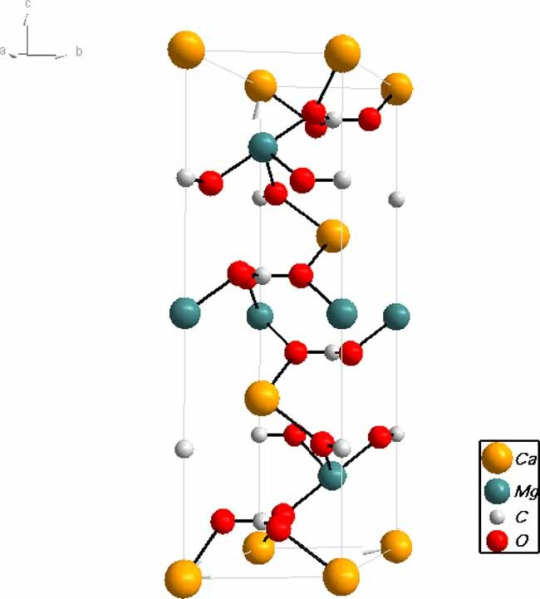
This means that dolomite is primarily found in areas with high evaporation since they require high concentrations of magnesium in solution. Evaporation causes calcite-based minerals to evaporate out, creating a higher Mg/Ca ratio. This means that dolomite can form at salt flats (sabkhas), tidal zones, seepage areas, and so on.
Image sources: 2, 3, 4, 5
Image 1 from me
#rockposting#vpoc yells#vpoc writes#vpoc has cool rocks#this is a reminder that at any moment you can say 'hey vpoc tell me about the rock closest to you' and i will#dolomite
8 notes
·
View notes
Text
I didn't even talk about farming in my Techno as Trade post even though that's the reason I had the idea in the first place because I'm a fool that wrote the whole post at like 2 a.m.
SO, why I thought Technoblade could be a god of trade, through the lense of farming:
Technoblade is very well known for his success in the Potato wars. While this was a competition between farmers, the fact that it was a war is evident in the tactics used, the time and resources invested, and the mentalities of those involved. It was far more similar to a military campaign than a gardening competition. So, if Technoblade is often treated as a character closely connected to war and therefore bloodshed, but this war had no bloodshed, what is the connection between the two? The connections I found were strategy, respect, trust, and most importantly, trade.
In pvp Technoblade might trade a few hits to himself for an opportunity for a crit. In the potato war technoblade trades time that could be spent farming for an opportunity to evaluate squidkid's methods. In both cases Technoblade has absolute respect for his opponent, but also knows that actions that may seem to be a disadvantage to him may end up being an opportunity to gain valuable intel about the opponent. As discussed in the other post, in war the lives of others may be sacrificed as a trade for survival. In farming, time and effort are traded for the growth of life.
Another aspect that made me consider this idea was Philza retelling stories of Technoblade's hyperfocus on the potato war and the concern his friends had for him. While I know this was a facet if Technoblade's real-life actions and not of his character, his character often reflects that same motivation and dedication, investing his abilities at the cost of himself in order to achieve a larger goal. For instance: farming for hours in the potato war, acting as a sell sword for pogtopia, creating farms and finding armor for the resistance, hiding Tommy, and going to prison for Dream. Each of these examples came at a cost to Technoblade that he traded for his values: dedication and respect of his opponent, anarchy, choice, hospitality, reciprocity, and a life free of control. The trades that Techno makes are not equal trades. Absolute reciprocity does not mean 'fairness'. Trade means that what is traded is perceived by the scale of the value it had to a specific person.
But, back to the farming.
To farm, one is required to invest time, energy, resources, and careful effort for the trade of growth and life. Technoblade does this often: in the potato war, in his retirement, in the syndicate, planting both literal and metaphorical seeds to grow. Plants are a trade of life just as much as war is, although trading water for growth that will be used as food to sustain life is a much more palatable circle of life than trading blows on a battlefield to end one life to save your own.
I've mentioned this before, but I've always associated Technoblade with roses. Did you know roses grow well with blood? The nitrogen helps them grow. But these plants, with their thorny outside that protects delicate petals growing on blood, remind me of Technoblade's reputation as the blade and as the blood god hiding his carefully cultivated trust. But Technoblade trades his time and efforts for his goals. Trades his retirement for his violent reputation to gain protection. Trades violence for choice. Trades freedom for his values. He trades, and slowly - so slowly - the goals he was always trying to achieve begin to grow, just as his garden in that arctic frost begins to grow.
Farming is a trade in the most basic sense. We trade effort and time for growth. But there are many things that grow, and many things to trade for them.
#Went off on a tangent AGAIN. seriously only meant to talk about the potato war but here we are.#techno as trade my beloved#vpoc yells#technoblade#c!technoblade#technoblade analysis#headcanon#long post#vpoc writes
91 notes
·
View notes
Text
Technoblade and Flower Symbolism: Part Two
Here's Part one: Dandelions
Poppies
There are two main symbolic meanings that are common for poppies: hope for a peaceful future and remembrance (usually remembrance of death - poppies are often used as memorial flowers for war veterans). A couple poppy fun-facts: They were used in poetry about deaths due to war as far back as the Iliad (Greek mythos connection = Technoblade connection, right?), and were often found in abandoned battlefields since mortar rubble provided lime and space for them to grow.
Most people know their role in remembrance of war, but few people use poppies to symbolize hope for a peaceful future. I feel that this represents Techno well. He has his personal drive for peace, and choice, and an end to the violence, but many people see him and automatically think of war.
Another reason that I use poppies for art of Techno, other than the clip where he collects them and the symbolism, is a personal headcanon of mine. I know that we don't know much about Technoblade's character before the DSMP, but even before it was revealed that he only had one life it was already a headcanon of mine that he did. Technoblade's character acted like he had been through war and worse already, and the almost-execution and extra precautions he took seemed to reflect that.
On a less serious note, the image of a field of blood-red poppies, known to represent the fallen of war, seemed perfect for a man that calls for blood for the blood god.
On an even less serious note, poppies are used to make opiates and can cause people to sleep and that pig 100% hibernates like the dead.
Roses
Roses are a big one to me! I didn't gravitate towards roses for their symbolism or role in society, but there are reasons that I think they fit Technoblade well!
The main reason is their thorns. Roses are a defensive plant, with thick briars to ward of threats. I like to think of the curling vine of thorns as a representation of how others see Technoblade, and the delicate petals as a representation of his one life, but also as a representation of his trust. Technoblade gives trust easily, and so very often has it turned against him despite his many physical defenses. There are things that can get past even the thorny reputation of The Blade.
The silly reason that I associate Technoblade with roses is that roses thrive with blood! Unironically, bloodmeal or raw meat is great for a rose bush and I thought it would be funny if someone asked Techno how he grew his plants so well and he just went "blood" in a complete deadpan.
Another serious reason, but not a real-life one, is the association with withers. Wither roses are, to me, a representation of transformation, life, and the trade between life and death. Roses created from the death of something else that have the potential to live on their own through thay death but also have the potential to cause death in the same way they were created? As someone who associates Techno heavily with the exchange of life and death, wither roses are a great symbolic tool to represent the potential for creation that is found in destruction... for instance the creation of freedom and healing found in the destruction of a government...
#not as serious as the other one but still! this is just why i draw these with techno not anything super deep lol#technoblade#c!technoblade#vpoc yells#long post#vpoc writes
26 notes
·
View notes
Text
Okay, yeah I'm done with staying out of the fandom drama now. This is going to be dsmp fandom critical.
Guys. I am so tired of seeing people threatened, insulted, and compared to abusers for saying that they like a character. I've seen this for c!techno, but mostly I see it for c!Dream. It's awful, and uncalled for, and harmful in so many ways. Just because someone likes c!Dream but doesn't have an essay response for every action he's done, or calls him morally grey, is no reason to attack them. Moreover, it absolutely is harmful to say that c!dream is sub-human, or irredeemable, or purely evil, even if he was played as a villian. And you know what? I see almost none of this about c!quackity or c!Sam, who also tortured and abused people. And I think the reason for that is because of what is said about c!dream. It's treated like the abuse is okay because c!dream abused others, and that's harmful!
This is part of the purity culture that we're so engrossed in that is actively damaging people's ability to grow. I know it's not the exact same thing, but hearing people say that c!dream is purely evil, subhuman, and can't possibly be morally grey because of what he did, reminds me of people in real life being doxxed, attacked, and threatened for things they said over eight years ago. It reminds me of history lessons talking about how the opposing side would look for past issues to justify attacking entire groups of people.
It reminds me of being in the magnus archives fandom and seeing posts about how it should be criticized for "copganda" because it had cop characters with story arcs. This is the clearest comparison I can think of, and I think it's important to point out that I NEVER saw people being threatened for liking the characters in the magnus archives. Because it is unjustified to threaten someone over a fictional character. But importantly to this topic, the reason the criticisms were there was because the cop characters - despite being affected by powers and given distinctly inhuman traits- were considered to be "too humanized" and "too sympathetic" to be good representations of cops. Just because they had motivations, and arcs, and friends, and they changed, they were suddenly 'harmful.' But that's how cops are. That's how abusers are. That's how people who do evil and cruel things are. BECAUSE THEY ARE PEOPLE. The entire story they were used as caricatures to show how easily corruption spread in positions of power through misplaced senses of power or compliance with a system. These are human flaws. C!Dream does the same thing with his execution of his plan to unite the server. It's a good motivation twisted through execution to feature horrible actions and choices.
What is accomplished by denying the humanity of a person or a character because of what they have done isn't that it shows people that what they did is bad. We, for the most part, already know that. What it does do is show people that someone who has done a bad thing can't change, that they're less than human, and that they can be punished for it. What if an abuser uses this mindset and justifies their actions by some "bad" thing the other person has done that makes them less than human? That's what governments do in conflicts and it's people are doing on a smaller scale when they say torture is justified because of c!dream's past actions. What if someone in a bad situation stays because the person harming them is kind and thoughtful sometimes? With black and white perspectives of good and evil it would make sense that a person who does good things can't actually be bad, right? Or that the view that "all cops are bastard" can't be right because evil cops aren't people but your brother is a good person and he's a cop. It excuses actions and systems by saying that they are the consequences of subhuman monsters, not people who are cruel and manipulative because they were put in the position to act that way and decided it was the best path. People who do evil things are still people. People who made mistakes and changed are still people. That doesn't mean that they need to be forgiven or excused, or that they suddenly become good as soon as they stop doing evil. It means that harm is not excused by what "evil" another person has done. And it means that everyone needs to be aware that people are capable of bad things in order to evaluate how to avoid it in their own lives.
It also means that this is a minecraft roleplay series and real people should not suffer for thinking a character is interesting, and characters have no need to be used as vessels of harmful ideology.
#thisvwill be interesting i think#sorry to everyone on my dash trying to avoid drama. i was tired of seeing it.#fandom critical#dsmp fandom critical#dsmp#c!dream#c!dream critical#(just in case)#cw abuse mention#cw police#long post#vpoc yells#discourse#vpoc writes
16 notes
·
View notes
Note
Thinking about your “Techno as trade” post and could only think: War is a gamble. An uncertain exchange, a bet with high stakes. And now I am Techno trade brain
Slowly drew you guys in with silly art to reveal my true motivations: converting everyone to Techno as Trade
But yes anon!! War is a gamble and the result involves trading lives and violence for survival and gain. The stakes are uneven, and unfair, and that's how any trade involving life is; and Techno knows this so well
3 notes
·
View notes
Text
Loyal!!! @simplepotatofarmer I really wanted to do your art event and I finally had some time off! I only had time for sketches but I hope you still like them!




#i am so sorry i couldn't spend more time on this :< i was really excited about it and this is the only break they said we would have!#so i wanted to at least send you these sketches since i wouldn't have time to make a full piece.#if i have time next month I'll redo these! but that's after the event is over 😔#hey loyal write this#If you want to!! love you!!#(also lmk of you want me to type out the text i know it's hard to read)#vpoc draws#sketch
115 notes
·
View notes